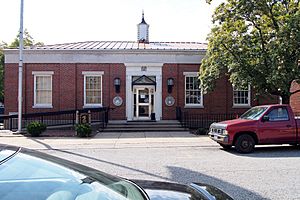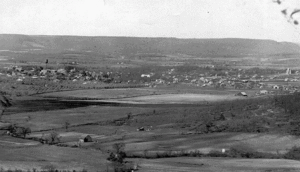Berryville, Arkansas facts for kids
Quick facts for kids
Berryville, Arkansas
|
|
|---|---|

Berryville Town Square (2006)
|
|

Location of Berryville in Carroll County, Arkansas.
|
|
| Country | United States |
| State | Arkansas |
| County | Carroll |
| Founded | 1851 |
| Area | |
| • Total | 6.15 sq mi (15.93 km2) |
| • Land | 6.15 sq mi (15.93 km2) |
| • Water | 0.00 sq mi (0.00 km2) |
| Elevation | 1,243 ft (379 m) |
| Population
(2020)
|
|
| • Total | 5,682 |
| • Density | 923.90/sq mi (356.70/km2) |
| Time zone | UTC-6 (CST) |
| • Summer (DST) | UTC-5 (CDT) |
| ZIP code |
72616
|
| Area code | 870, exchange 423,480 |
| FIPS code | 05-05560 |
| GNIS ID | 2403863 |
Berryville (/ˈbʌr.əˌvʊl/ burr-Ə-vul) is a city in Carroll County, Arkansas, United States. In 2020, about 5,682 people lived there. This makes it the largest city in Carroll County. Berryville is one of two county seats for Carroll County, meaning it's a center for local government. The other county seat is Eureka Springs.
Contents
History of Berryville
Berryville was started in 1850 by a local person named Blackburn Henderson Berry. His nephew, James Henderson Berry, later became the 14th governor of Arkansas in 1883. The city officially became a city in 1876.
Geography and Location
Berryville is located in Carroll County, Arkansas. It covers an area of about 6.15 square miles (15.93 square kilometers), and all of it is land.
Main Roads in Berryville
U.S. Route 62 goes right through the middle of Berryville.
- If you go east on US 62, it's about 30 miles (48 km) to Harrison.
- If you go west on US 62, it's about 46 miles (74 km) to Rogers.
- Eureka Springs is about 12 miles (19 km) west on US 62.
Arkansas Highway 21 goes north from Berryville. It's about 16 miles (26 km) to the Missouri state line.
Population and People
| Historical population | |||
|---|---|---|---|
| Census | Pop. | %± | |
| 1880 | 253 | — | |
| 1890 | 549 | 117.0% | |
| 1900 | 551 | 0.4% | |
| 1910 | 785 | 42.5% | |
| 1920 | 1,474 | 87.8% | |
| 1930 | 1,286 | −12.8% | |
| 1940 | 1,482 | 15.2% | |
| 1950 | 1,753 | 18.3% | |
| 1960 | 1,999 | 14.0% | |
| 1970 | 2,271 | 13.6% | |
| 1980 | 2,966 | 30.6% | |
| 1990 | 3,212 | 8.3% | |
| 2000 | 4,433 | 38.0% | |
| 2010 | 5,356 | 20.8% | |
| 2020 | 5,682 | 6.1% | |
| U.S. Decennial Census 2014 Estimate |
|||
In 2020, Berryville had 5,682 people living in the city. There were 2,009 households and 1,269 families. The city is home to people from many different backgrounds.
Education in Berryville
Students in Berryville attend public schools run by the Berryville School District. Students go to elementary and secondary schools, and they graduate from Berryville High School.
Fun Places to Visit

There are several interesting places to see in and around Berryville:
- Saunders' Museum: This museum is in the center of town. It has a collection of old guns, including some that were used by famous figures like Pancho Villa and Billy the Kid. It also has many other cool items.
- Cosmic Cavern: This amazing cave is about 7 miles (11 km) north of Berryville on Arkansas Highway 21. You can explore its underground wonders.
- Handgun Companies: Berryville is home to companies like Nighthawk Custom and Wilson Combat, which make handguns. It also hosts the International Defensive Pistol Association, which organizes sports competitions using handguns in a safe way.
- Little Portion Hermitage: This is a special community founded by the Christian musician John Michael Talbot. It is located just outside of Berryville.
Getting Around Berryville
Roads
Berryville is connected by several important roads:
 US Highway 62
US Highway 62 US Highway 62 Spur
US Highway 62 Spur Arkansas Highway 21
Arkansas Highway 21 Arkansas Highway 143
Arkansas Highway 143 Arkansas Highway 221
Arkansas Highway 221 Arkansas Highway 980
Arkansas Highway 980
Bus Service
- You can also travel to and from Berryville using Jefferson Lines bus service.
Famous People from Berryville
Several notable people have connections to Berryville:
- Bob Ballinger: He is a member of the Republican party and serves in the Arkansas House of Representatives. He lives and has a law office in Berryville.
- James Henderson Berry: He was a U.S. senator and the 14th governor of Arkansas.
- Bradely Bunch: He was a state senator in 1885.
- James William Trimble: He was a former congressman.
- Bill Wilson: He is the founder of Wilson Combat, a company that makes firearms in the U.S.
See also
 In Spanish: Berryville (Arkansas) para niños
In Spanish: Berryville (Arkansas) para niños


